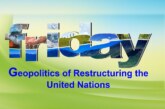Director General |NMCG | Ministry of Jal Shakti | Government of India

Mr. Rajiv Ranjan Mishra, Director General, National Mission for Clean Ganga, Ministry of Jal Shakti, Government of India. With a demonstrated history of more than 30 yearsas an Indian Administrative officer, Skilled in Sustainable Development, Analytics, Government, Urbanization, Housing, Water Resource Management, and Policy Analysis. Strong business development professional with a Certificate of Advanced Studies in Public Administration focused in Public Administration from Syracuse University – Maxwell School, USA and Certificate on Project Management from UC, Berkeley, USA.
INTERVIEW
Mr Mishra, you have highlighted that Ganga is poised to be safe for ‘bathing quality’ in 97 towns in 2 years. Would you share with us what ‘Convergence’ directions are taken in this regard?

River Ganga is not only the cultural and spiritual mainstay for India but also provides economic sustenance, water and food security to more than 43% of the country’s population. I would like to highlight that around forty percent of the projects along the main stem of the Ganga in 97 towns (about 45 of the 113 projects) have been completed or are near completion and am much hopeful to bring in bathing water quality across the entire main stem of the Ganga within two years. The results of Namami Gange’s efforts have started appearing on the ground.
With Ganga considered the most revered river across the world, the Namami Gange programme, implemented by the National Mission for Clean Ganga (NMCG) has been an integrated mission for conservation of Ganga and its tributaries. The success can be attributed to the comprehensive Ganga River Basin Management Plan (GRBMP) comprising Integrated River Basin Management (IRBM) approach which is followed with multi sectoral and multi-agency interventions such as pollution abatement (Nirmal Ganga), improving ecology and flow (Aviral Ganga), strengthening people river connect (Jan Ganga) and facilitating diversified research, scientific mapping, studies and evidence based policy formulation (Gyan Ganga).
A total of 326 projects have been sanctioned under the Namami Gange programme at a cost of Rs. 29186.58 crores. 137 projects have been completed and the remaining are in progress. The pace of execution and consequently the expenditure has increased manifold with the expenditure for the FY 2019-20 being Rs. 2673.09 crores as compared to Rs. 170.99 crores in the FY 2014-15. Environmental Awareness through campaigns like Ganga Run, Ganga Amantran, Ganga Utsav, Ganga Quest, community engagement through IEC activities is fostered for maintaining the cleanliness of the river and its conservation.
Under pollution abatement, the Sewage treatment capacity in Uttarakhand in 2014 was limited to only 61.5 MLD. Out of this, 45 MLD capacity needed improvement. Under Namami Gange, 45 MLD STP capacity has been rehabilitated and 153 MLD new capacity has been created. This has improved the sewage treatment capacity to 214.5 MLD, adequate for 15 years. Through the Mission, the focus now has been shifted from pollution abatement to urban renewal not only in the sector of water and sanitation but also through providing the open spaces to the cities so that nature and urban population can coexist together.
Out of 38 projects sanctioned on the tributaries of river Ganga under Namami Gange, 20 projects have been sanctioned on river Yamuna alone. Starting from Poanta Sahib in Himachal Pradesh, Sonipat and Panipat in Haryana, Delhi to Etawah in Uttar Pradesh, projects have been sanctioned all along the Yamuna river to curb the sewage pollution. Under the same programme, a total of 52 projects of sewerage infrastructure, Ghats and crematoria, biodiversity, Afforestation etc. have been sanctioned at the cost of Rs. 1514.34 Crore which are at different stages of implementation. For example, the river Ganga flows for almost 450 km in Bihar and there are 17 important towns along the banks of the Ganga which generate the sewage load and contribute to the pollution in the river. Uttar Pradesh has started taking stringent action against people and units polluting the Ganga in the state.

River waterfront development on various banks has greatly enhanced ecological awareness and tourism for the river edge and thus prevented disposal of untreated sewage into the river and also solid waste dumping on the riverbanks. For instance, around 13 projects to create 25 Ghats and 26 Crematoria are sanctioned in important towns of Uttarakhand at a cost of Rs 259.83 Crore. A river front has been developed for the people of Haridwar at Chandi Ghat with a cost of Rs 69.18 Cr. Murals and facelift have also been done at prominent places in Haridwar like Clock Tower, Chandi Ghat and Way to Mansa Devi Temple.
NMCG, meanwhile, is looking to ensure enforcement provisions under green laws that include Environment Protection Act, Solid Waste Management Rules 2016, Plastic Waste Management Rules, 2011 and Section 133 of the Indian Penal Code on causing ‘public nuisance’ which is more actively wielded to check pollution in the Ganga. For example, project to mainstream river health in urban planning and develop framework for Integrated Urban Water Management (IUWM) has been initiated with National Institute of Urban affairs. Innovative urban river management plan (URMP) framework is being developed with a template for Kanpur.
Further, targets are raised considering the scale and size of the Mission vis-a-vis Ganga projects andthe Centre has estimated that nearly 100% of the project work has been completed in Uttarakhand and Jharkhand, while it is 50%-60% in Uttar Pradesh and about 30%-40% in West Bengal and 25%-30% in Bihar. With the commissioning of Sewage Treatment Plants, the water quality of Ganga river has improved, now the water quality of Ganga has become ‘A’ class in the entire Uttarakhand, which is the best river water quality.
Hon’ble Prime Minister Shri Narendra Modi appreciated the Mission for the new approach taken towards the Ganga Rejuvenation while inaugurating sewerage projects in Uttarakhand.
The NMCG has already begun sensitizing states and the Ganga committees chaired by District Magistrates to use existing laws to crack down on polluters. Further, Ganga Museum connected with the heritage of Ganga is going to be a new medium of connection with the tourists.
The present day scenario is grim with COVID-19 complicating the water security of India. Under your stewardship, how is your department under Namami Ganga Programme spearheading strategies to address this alarming scenario, especially in the light of SDGs Agenda 2030?
We all saw during the lockdown period that nature has the capacity to rejuvenate itself if human interventions are controlled. I personally believe that the lesson to be learnt is that we need to have a better enforcement and also keep working for behavioural change as everything cannot be achieved by regulatory approach only. Moving beyond silos, integrated and collective efforts holds the key to preserve the sanctity of the river Ganga.

Ganga is in the heart of millions who are drawn to it since time immemorial. In essence, Ganga represents all rivers and several rivers and there is no doubt that Ganga provides a lifeline for about 450 million people in high population density zonesin India, including more than 50 major cities located in its basin. Its waters contain around 25% of all water resources of India. The river basin significantly contributes to food production with 50% of the area irrigated for agriculture and a high potential for fisheries. It has always been and will remain a great unifying force. During the rest of the year, irrigation, navigation, and ecosystems suffer because of water scarcity. Rapid urbanization, industrial and agricultural processes heavily affect the water quality and quantity of the Ganga River in its entire basin. India faces a huge challenge about pollution of the water systems around Ganga as well as waste management in cities and river basins. On top of that, climate change, and specifically the changing monsoons, is severely affecting the water supply and quality of the river. The dwindling of Ganga river would severely affect water available for surface water irrigation, with potential future decline in food production. This decline in river flow also has implications for achieving the UN Sustainable Development Goals by 2030.
Approaches to managing water resources in such basins is upstream storage of excess wet-season river flow for use during dry season. This requires conjunctive-use management strategies. Its rejuvenation needs all to join and its rejuvenation is needed by all. Sustainable development increasingly depends upon successful management of urban growth and water resources. Ganga Rejuvenation is critical for implementation of the 2030 agenda of sustainable development goals (SDGs). Namami Gange has developed a framework for river rejuvenation which is now being followed for several rivers beyond Ganga basin. People’s participation is key to bring transformation and all key strategies have been community oriented.
The theme for World River Day 2020 was “Day of action for rivers”. This is significant understanding that rivers form a profound backbone for biodiversity, wetlands, and livelihoods of people. Can you throw some light on this aspect?
NMCG is also working for improving flows and overall ecology through a mix of supply as well as demand side management of water. For the first time, ecological flow was notified for River Ganga in October 2018, formally establishing the right of the river over its own water with far reaching implications for river health. This has become a major component of river rejuvenation and studies are ongoing for other rivers like Yamuna, Ramganga etc.
Wetlands are important for Nirmalta, Aviraltaand for economy, eco-tourism, ground water recharge and supporting biodiversity. Under NMCG, the Mission is working for the protection and conservation and integrating to basin level also developing toolkits for urban wetlands protection and giving special attention to flood plain wetlands. I would like to bring to notice that around 226 wetlands within 10 kms from Ganga in 27 districts in UP have been taken up for development of an integrated management plan.

A comprehensive project is under implementation with Wildlife Institute of India (WII) to map biodiversity hotspots for the entire length of Ganga and scientific improvement of habitat, species. NMCG spearheaded the campaign for conservation of the Gangetic Dolphin, the National Aquatic Animal leading to announcement of Project Dolphin by the Hon’ble Prime Minister. A comprehensive scientific program for fisheries resource and their conservation has been taken up in association with Central Inland Fisheries Research Institute (CIFRI). With years of painstaking efforts and stakeholder-led cooperation, nearly 50 per cent of the Ganga river has “very high biodiversity levels” and the sightings of biodiversity indicators, such as the Gangetic Dolphin and Otters, have increased over the last few years.
Further, a Ganga Museum named ‘Ganga Avlokan’ has been developed on Chandi Ghat. This is an effort to make people aware of the cultural importance of river Ganga, biodiversity and efforts being made for its conservation. A souvenir shop has also been developed which will also facilitate marketing of products made by trained Ganga Praharis mainly from the Ganga villages at the community level. Such efforts will give us strength in the direction of connecting all Ganga Praharis, Ganga defenders.
Realizing that sustainable agriculture is key forensuring both Aviralta as well as Nirmalta of Ganga, scaling up the program for organic farming along Ganga has become a part of the action plan of states and the Ministry of Agriculture and Farmer’s Welfare. Organic farming is done within 5kms on both sides of the river Ganga. Further, several wetlands on the Ganga basin are home to key flora and fauna, including migratory species. Citing an example of Deoria Tal, one of the high altitude wetlands in Uttarakhand, whichhas wonderful scenic beauty.
Visualizing the Ganga Grams as model defecation-free villages, a lot more is focused on waste management, wetland conservation and livelihood development. What are the achievements under Namami Ganga programme?
Under Namami Gange, the focus is on the interlinking of Ganga and the villages along the Ganga river. To rejuvenate the river, it is important to focus on the village agglomeration along the river and the livelihoods of people. Under the mission around 11 lakh independent household toilets in 4465 identified villages have been constructed in the five River Ganga states. All these Ganga bank villages have now been declared open defecation free (ODF).
River Rejuvenation is a continuous process which necessarily needs involvement of people. The village-river connect is being strengthened to join these efforts and maintain beauty and cleanliness. The then Union Ministry of Water Resources, River Development and Ganga Rejuvenation also deployed the first company of Ganga Task Force Battalion to fast-track implementation of the Namami Gange Programme. It was deployed first at Garhmukteshwar town in Hapur district of UP. Three such companies will be deployed soon at Kanpur, Varanasi and Prayagraj. The force comprising this project will be deployed soon at the banks of the river Ganga to ensure that industries and local citizens do not pollute the river.
There are many wetlands, that are highly productive ecosystems supporting rich biodiversity that protect the environment in various ways including supply of water, aiding in its purification and waste assimilation. NMCG, in collaboration with the State Wetland Authorities, will help in identifying and preparing Integrated Management Plans for management and conservation in the Ganga basin. I believe if we don’t encroach on them, they also help in mitigating some pollution because some minor pollution in villages can be treated through the wetlands.
Afforestation along the Ganga is in progress as per the scientific plan by Forest Research Institute (FRI), Dehradun. An all-inclusive project for medicinal plantation in 10 districts of UP has been taken up with comprehensive backward and forward linkage in 2500 Ha. Atmanirbhar Bharat in the agriculture sector has given a big boost for herbal plantation in the country and along the Ganga.
Self-motivated and trained volunteers (Ganga Praharis) from among the local communities are working for biodiversity conservation and cleanliness of the Ganga River with the ultimate objectives of restoring the Nirmal and AviralDhara. To make this initiative sustainable and reduce direct dependencies on the River, Ganga Praharis’ livelihoods have been linked with biodiversity conservation and instead of short-term direct monetary benefits; emphasis has been laid on their skill development through regular training. NMCG along with WII, established skill development and livelihood centres in the Ganga states that offertraining in sewing, handicrafts, nursery development, health and wellness from locally grown organic products, incense making, value added food products and biodiversity-based tourism. To create market linkages for these products floating livelihood centres known as “Jalaj” are being developed. Jalaj comprises of a small shopping complex where Ganga Prahari products are being sold and through nature-based tourism services providing glimpses of Ganga biodiversity, cultural heritage and village life.
Small rivers and water bodies deserve equal attention and consideration. Hearing your proactive efforts towards rejuvenation of smaller rivers in India is a welcome step. Can you elaborate for our viewers?

Namami Gange mission has shifted its approach from Ganga main stem to river basin approach. The efforts of Ganga rejuvenation cannot be achieved until its tributaries are also rejuvenated. Under the mission Namami Gange have taken up projects on 12 important tributaries of the Ganga. But for ensuring flow during lean season and rejuvenation of bigger rivers, it is important that smaller rivers carry flows and remain in state of good health with quality of water conforming to bathing standards. Their challenges have remained similar to big rivers that includes rapid urbanization, population rise, climatic changes, indiscriminate extraction of natural resources which has transformed them into small drainage channels.
During World Rivers Day 2020, I had stated that if we see the map of all smaller rivers, it looks like a network of arteries and veins. Hence, for the overall health of ecology, it is extremely important to revive smaller rivers. Further, rivers are not only water but a complete system which includes biodiversity, sediments and spiritual and cultural aspects. Every river has represented an integral part of Indian spirituality, a symbol of faith, hope, culture and sanity and the centre of social and religious tradition since ages.
Six districts presented case studies on smaller river rejuvenation in this first edition of small river rejuvenation series by Namami Gange. For example, the DM of Tehri Garhwal, Uttarakhand shared that a catchment area of 16,481 Hectares has been identified and 9 micro watersheds have been surveyed for treatment to rejuvenate Heval river, an important tributary of Ganga. Similarly, extra ordinary workshave been done to revive Budhi Ganga river. In some of the districts, sewerage infrastructure related works for smaller rivers are already underway through the Namami Gange Programme. Recently the rejuvenation of small rivers has gained much attention and it has been got included as priority under MGNREGA. The small rivers will also be of major focus in Jal Shakti Abhiyan 2.In short, interventions through integrated management, community participation must be fast paced in restoring, maintaining and sustaining the critical balance of smaller river ecosystems along with large rivers.



